Exploring Key Themes in Nathaniel Hawthorne's 'Young Goodman Brown'
VerifiedAdded on 2020/04/01
|6
|1773
|330
Essay
AI Summary
This essay provides a thematic analysis of Nathaniel Hawthorne's 'Young Goodman Brown,' examining key themes such as Puritan values, sin, reality versus illusion, and symbolism. The author uses the journey of the protagonist, Young Goodman Brown, to explore the hypocrisy and moral decay within Puritan society, highlighting the conflict between outward appearances and inner corruption. The essay delves into the concept of sin as an inescapable aspect of human nature, the blurring of reality and illusion, and the use of symbolism to convey deeper meanings. The analysis references the protagonist's struggles with faith, temptation, and the loss of innocence, while also considering the story's enduring relevance and literary significance. The essay concludes by emphasizing the story's exploration of human fallibility and the darkness that can exist within individuals and communities.
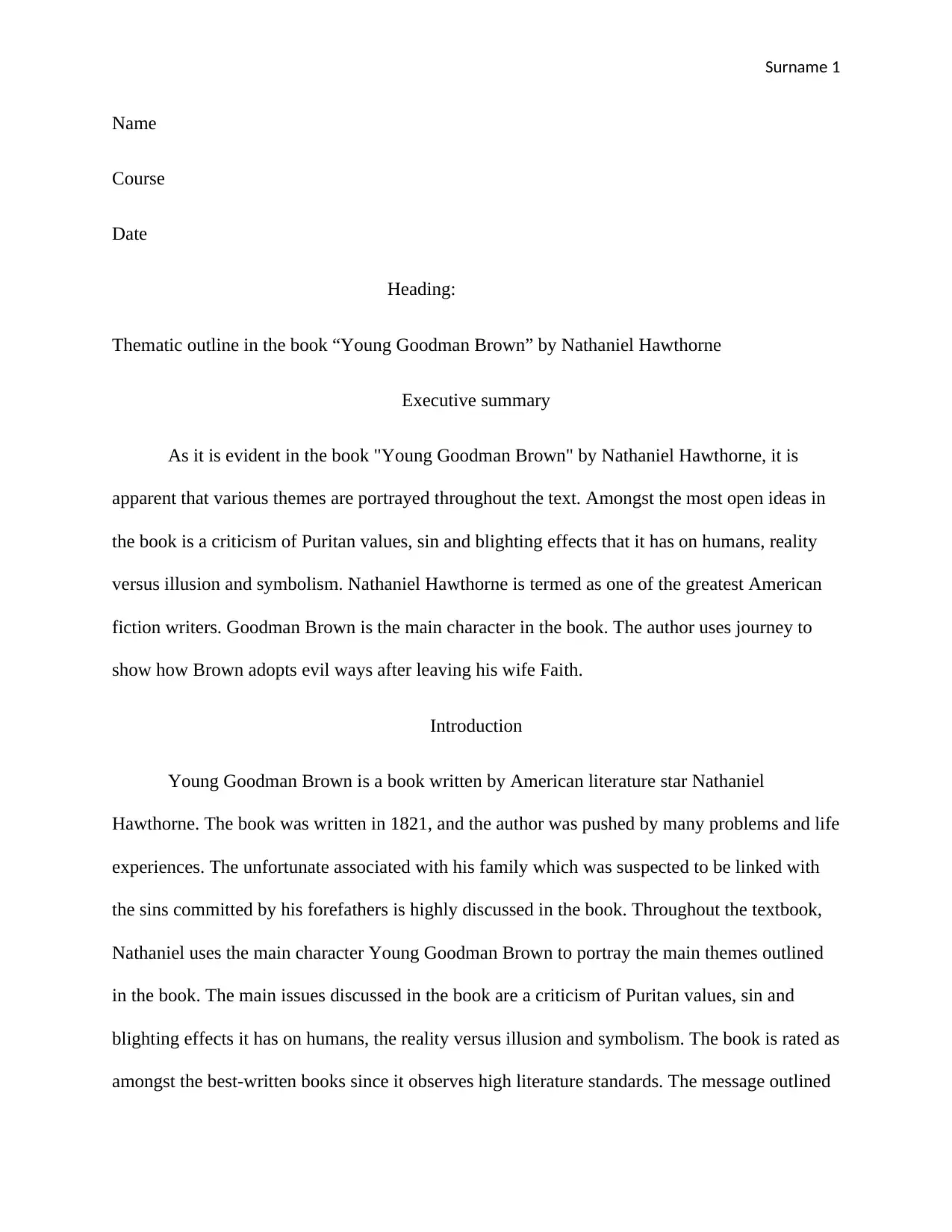
Surname 1
Name
Course
Date
Heading:
Thematic outline in the book “Young Goodman Brown” by Nathaniel Hawthorne
Executive summary
As it is evident in the book "Young Goodman Brown" by Nathaniel Hawthorne, it is
apparent that various themes are portrayed throughout the text. Amongst the most open ideas in
the book is a criticism of Puritan values, sin and blighting effects that it has on humans, reality
versus illusion and symbolism. Nathaniel Hawthorne is termed as one of the greatest American
fiction writers. Goodman Brown is the main character in the book. The author uses journey to
show how Brown adopts evil ways after leaving his wife Faith.
Introduction
Young Goodman Brown is a book written by American literature star Nathaniel
Hawthorne. The book was written in 1821, and the author was pushed by many problems and life
experiences. The unfortunate associated with his family which was suspected to be linked with
the sins committed by his forefathers is highly discussed in the book. Throughout the textbook,
Nathaniel uses the main character Young Goodman Brown to portray the main themes outlined
in the book. The main issues discussed in the book are a criticism of Puritan values, sin and
blighting effects it has on humans, the reality versus illusion and symbolism. The book is rated as
amongst the best-written books since it observes high literature standards. The message outlined
Name
Course
Date
Heading:
Thematic outline in the book “Young Goodman Brown” by Nathaniel Hawthorne
Executive summary
As it is evident in the book "Young Goodman Brown" by Nathaniel Hawthorne, it is
apparent that various themes are portrayed throughout the text. Amongst the most open ideas in
the book is a criticism of Puritan values, sin and blighting effects that it has on humans, reality
versus illusion and symbolism. Nathaniel Hawthorne is termed as one of the greatest American
fiction writers. Goodman Brown is the main character in the book. The author uses journey to
show how Brown adopts evil ways after leaving his wife Faith.
Introduction
Young Goodman Brown is a book written by American literature star Nathaniel
Hawthorne. The book was written in 1821, and the author was pushed by many problems and life
experiences. The unfortunate associated with his family which was suspected to be linked with
the sins committed by his forefathers is highly discussed in the book. Throughout the textbook,
Nathaniel uses the main character Young Goodman Brown to portray the main themes outlined
in the book. The main issues discussed in the book are a criticism of Puritan values, sin and
blighting effects it has on humans, the reality versus illusion and symbolism. The book is rated as
amongst the best-written books since it observes high literature standards. The message outlined
Paraphrase This Document
Need a fresh take? Get an instant paraphrase of this document with our AI Paraphraser
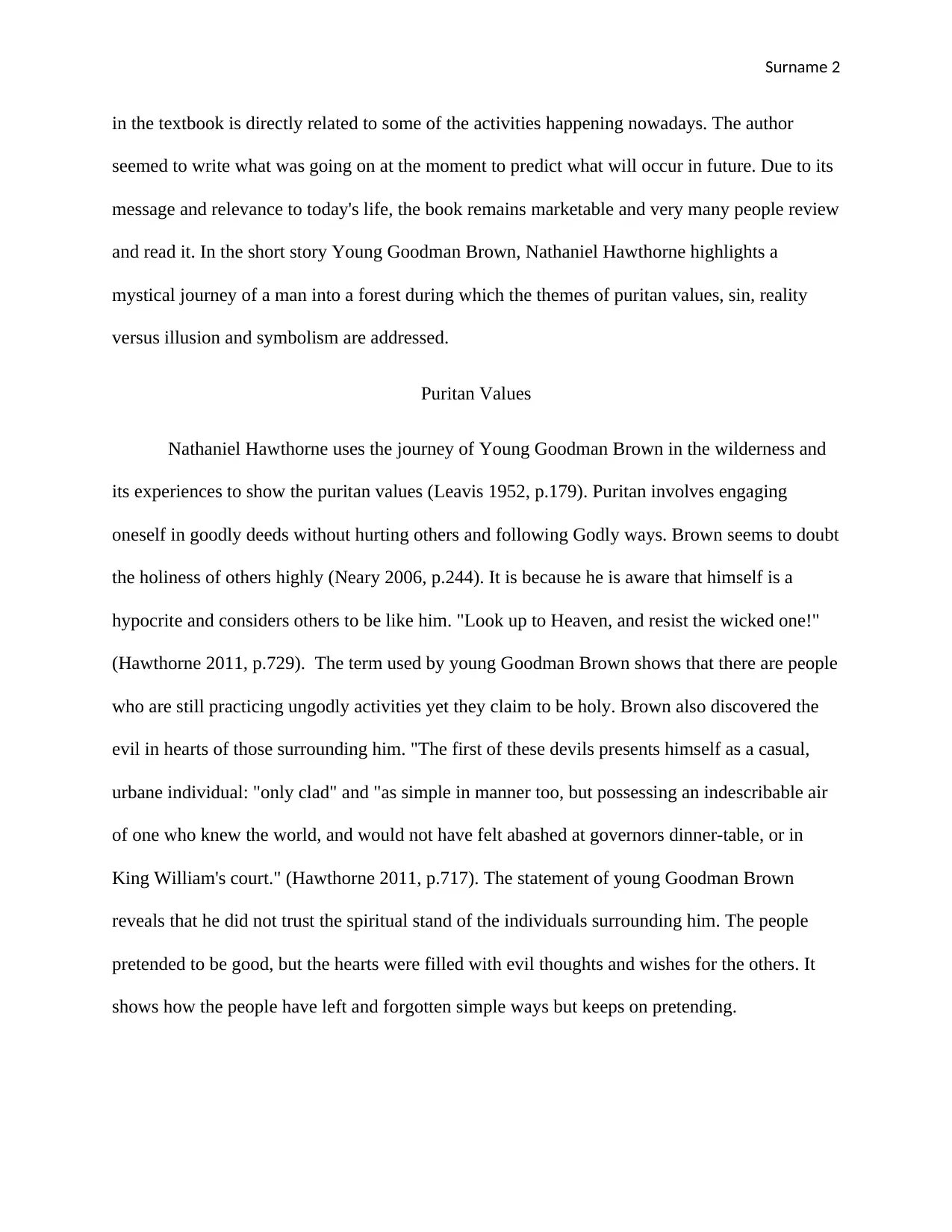
Surname 2
in the textbook is directly related to some of the activities happening nowadays. The author
seemed to write what was going on at the moment to predict what will occur in future. Due to its
message and relevance to today's life, the book remains marketable and very many people review
and read it. In the short story Young Goodman Brown, Nathaniel Hawthorne highlights a
mystical journey of a man into a forest during which the themes of puritan values, sin, reality
versus illusion and symbolism are addressed.
Puritan Values
Nathaniel Hawthorne uses the journey of Young Goodman Brown in the wilderness and
its experiences to show the puritan values (Leavis 1952, p.179). Puritan involves engaging
oneself in goodly deeds without hurting others and following Godly ways. Brown seems to doubt
the holiness of others highly (Neary 2006, p.244). It is because he is aware that himself is a
hypocrite and considers others to be like him. "Look up to Heaven, and resist the wicked one!"
(Hawthorne 2011, p.729). The term used by young Goodman Brown shows that there are people
who are still practicing ungodly activities yet they claim to be holy. Brown also discovered the
evil in hearts of those surrounding him. "The first of these devils presents himself as a casual,
urbane individual: "only clad" and "as simple in manner too, but possessing an indescribable air
of one who knew the world, and would not have felt abashed at governors dinner-table, or in
King William's court." (Hawthorne 2011, p.717). The statement of young Goodman Brown
reveals that he did not trust the spiritual stand of the individuals surrounding him. The people
pretended to be good, but the hearts were filled with evil thoughts and wishes for the others. It
shows how the people have left and forgotten simple ways but keeps on pretending.
in the textbook is directly related to some of the activities happening nowadays. The author
seemed to write what was going on at the moment to predict what will occur in future. Due to its
message and relevance to today's life, the book remains marketable and very many people review
and read it. In the short story Young Goodman Brown, Nathaniel Hawthorne highlights a
mystical journey of a man into a forest during which the themes of puritan values, sin, reality
versus illusion and symbolism are addressed.
Puritan Values
Nathaniel Hawthorne uses the journey of Young Goodman Brown in the wilderness and
its experiences to show the puritan values (Leavis 1952, p.179). Puritan involves engaging
oneself in goodly deeds without hurting others and following Godly ways. Brown seems to doubt
the holiness of others highly (Neary 2006, p.244). It is because he is aware that himself is a
hypocrite and considers others to be like him. "Look up to Heaven, and resist the wicked one!"
(Hawthorne 2011, p.729). The term used by young Goodman Brown shows that there are people
who are still practicing ungodly activities yet they claim to be holy. Brown also discovered the
evil in hearts of those surrounding him. "The first of these devils presents himself as a casual,
urbane individual: "only clad" and "as simple in manner too, but possessing an indescribable air
of one who knew the world, and would not have felt abashed at governors dinner-table, or in
King William's court." (Hawthorne 2011, p.717). The statement of young Goodman Brown
reveals that he did not trust the spiritual stand of the individuals surrounding him. The people
pretended to be good, but the hearts were filled with evil thoughts and wishes for the others. It
shows how the people have left and forgotten simple ways but keeps on pretending.
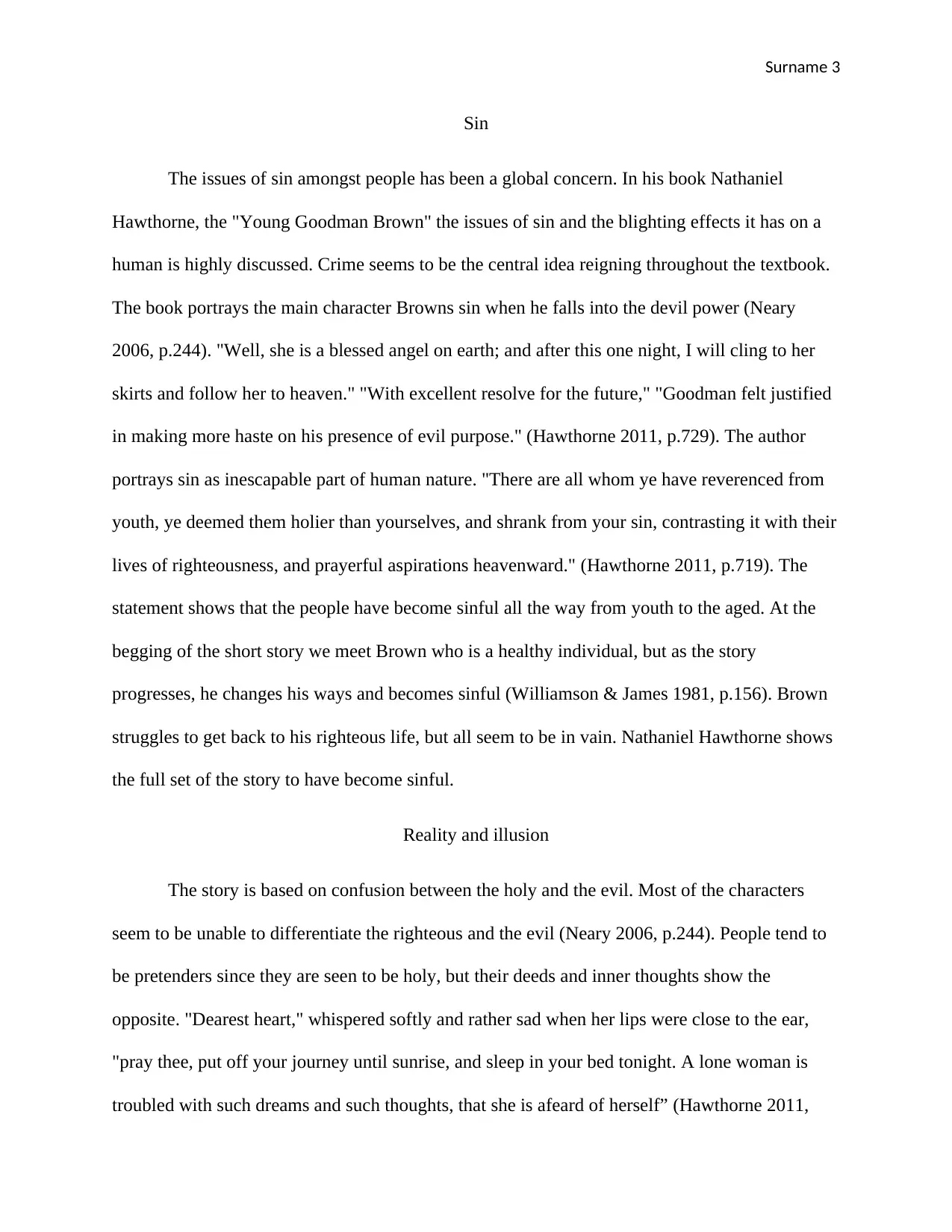
Surname 3
Sin
The issues of sin amongst people has been a global concern. In his book Nathaniel
Hawthorne, the "Young Goodman Brown" the issues of sin and the blighting effects it has on a
human is highly discussed. Crime seems to be the central idea reigning throughout the textbook.
The book portrays the main character Browns sin when he falls into the devil power (Neary
2006, p.244). "Well, she is a blessed angel on earth; and after this one night, I will cling to her
skirts and follow her to heaven." "With excellent resolve for the future," "Goodman felt justified
in making more haste on his presence of evil purpose." (Hawthorne 2011, p.729). The author
portrays sin as inescapable part of human nature. "There are all whom ye have reverenced from
youth, ye deemed them holier than yourselves, and shrank from your sin, contrasting it with their
lives of righteousness, and prayerful aspirations heavenward." (Hawthorne 2011, p.719). The
statement shows that the people have become sinful all the way from youth to the aged. At the
begging of the short story we meet Brown who is a healthy individual, but as the story
progresses, he changes his ways and becomes sinful (Williamson & James 1981, p.156). Brown
struggles to get back to his righteous life, but all seem to be in vain. Nathaniel Hawthorne shows
the full set of the story to have become sinful.
Reality and illusion
The story is based on confusion between the holy and the evil. Most of the characters
seem to be unable to differentiate the righteous and the evil (Neary 2006, p.244). People tend to
be pretenders since they are seen to be holy, but their deeds and inner thoughts show the
opposite. "Dearest heart," whispered softly and rather sad when her lips were close to the ear,
"pray thee, put off your journey until sunrise, and sleep in your bed tonight. A lone woman is
troubled with such dreams and such thoughts, that she is afeard of herself” (Hawthorne 2011,
Sin
The issues of sin amongst people has been a global concern. In his book Nathaniel
Hawthorne, the "Young Goodman Brown" the issues of sin and the blighting effects it has on a
human is highly discussed. Crime seems to be the central idea reigning throughout the textbook.
The book portrays the main character Browns sin when he falls into the devil power (Neary
2006, p.244). "Well, she is a blessed angel on earth; and after this one night, I will cling to her
skirts and follow her to heaven." "With excellent resolve for the future," "Goodman felt justified
in making more haste on his presence of evil purpose." (Hawthorne 2011, p.729). The author
portrays sin as inescapable part of human nature. "There are all whom ye have reverenced from
youth, ye deemed them holier than yourselves, and shrank from your sin, contrasting it with their
lives of righteousness, and prayerful aspirations heavenward." (Hawthorne 2011, p.719). The
statement shows that the people have become sinful all the way from youth to the aged. At the
begging of the short story we meet Brown who is a healthy individual, but as the story
progresses, he changes his ways and becomes sinful (Williamson & James 1981, p.156). Brown
struggles to get back to his righteous life, but all seem to be in vain. Nathaniel Hawthorne shows
the full set of the story to have become sinful.
Reality and illusion
The story is based on confusion between the holy and the evil. Most of the characters
seem to be unable to differentiate the righteous and the evil (Neary 2006, p.244). People tend to
be pretenders since they are seen to be holy, but their deeds and inner thoughts show the
opposite. "Dearest heart," whispered softly and rather sad when her lips were close to the ear,
"pray thee, put off your journey until sunrise, and sleep in your bed tonight. A lone woman is
troubled with such dreams and such thoughts, that she is afeard of herself” (Hawthorne 2011,
⊘ This is a preview!⊘
Do you want full access?
Subscribe today to unlock all pages.

Trusted by 1+ million students worldwide
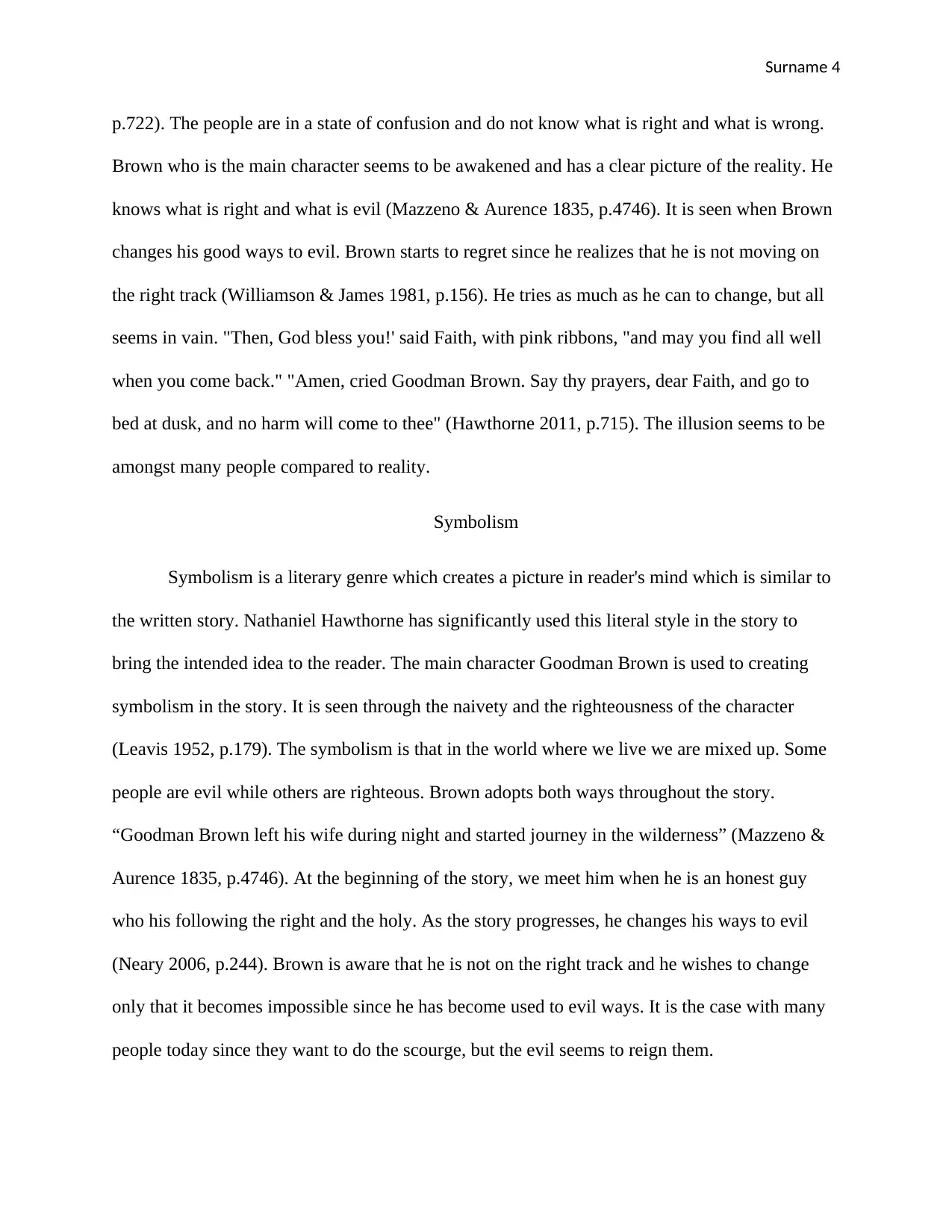
Surname 4
p.722). The people are in a state of confusion and do not know what is right and what is wrong.
Brown who is the main character seems to be awakened and has a clear picture of the reality. He
knows what is right and what is evil (Mazzeno & Aurence 1835, p.4746). It is seen when Brown
changes his good ways to evil. Brown starts to regret since he realizes that he is not moving on
the right track (Williamson & James 1981, p.156). He tries as much as he can to change, but all
seems in vain. "Then, God bless you!' said Faith, with pink ribbons, "and may you find all well
when you come back." "Amen, cried Goodman Brown. Say thy prayers, dear Faith, and go to
bed at dusk, and no harm will come to thee" (Hawthorne 2011, p.715). The illusion seems to be
amongst many people compared to reality.
Symbolism
Symbolism is a literary genre which creates a picture in reader's mind which is similar to
the written story. Nathaniel Hawthorne has significantly used this literal style in the story to
bring the intended idea to the reader. The main character Goodman Brown is used to creating
symbolism in the story. It is seen through the naivety and the righteousness of the character
(Leavis 1952, p.179). The symbolism is that in the world where we live we are mixed up. Some
people are evil while others are righteous. Brown adopts both ways throughout the story.
“Goodman Brown left his wife during night and started journey in the wilderness” (Mazzeno &
Aurence 1835, p.4746). At the beginning of the story, we meet him when he is an honest guy
who his following the right and the holy. As the story progresses, he changes his ways to evil
(Neary 2006, p.244). Brown is aware that he is not on the right track and he wishes to change
only that it becomes impossible since he has become used to evil ways. It is the case with many
people today since they want to do the scourge, but the evil seems to reign them.
p.722). The people are in a state of confusion and do not know what is right and what is wrong.
Brown who is the main character seems to be awakened and has a clear picture of the reality. He
knows what is right and what is evil (Mazzeno & Aurence 1835, p.4746). It is seen when Brown
changes his good ways to evil. Brown starts to regret since he realizes that he is not moving on
the right track (Williamson & James 1981, p.156). He tries as much as he can to change, but all
seems in vain. "Then, God bless you!' said Faith, with pink ribbons, "and may you find all well
when you come back." "Amen, cried Goodman Brown. Say thy prayers, dear Faith, and go to
bed at dusk, and no harm will come to thee" (Hawthorne 2011, p.715). The illusion seems to be
amongst many people compared to reality.
Symbolism
Symbolism is a literary genre which creates a picture in reader's mind which is similar to
the written story. Nathaniel Hawthorne has significantly used this literal style in the story to
bring the intended idea to the reader. The main character Goodman Brown is used to creating
symbolism in the story. It is seen through the naivety and the righteousness of the character
(Leavis 1952, p.179). The symbolism is that in the world where we live we are mixed up. Some
people are evil while others are righteous. Brown adopts both ways throughout the story.
“Goodman Brown left his wife during night and started journey in the wilderness” (Mazzeno &
Aurence 1835, p.4746). At the beginning of the story, we meet him when he is an honest guy
who his following the right and the holy. As the story progresses, he changes his ways to evil
(Neary 2006, p.244). Brown is aware that he is not on the right track and he wishes to change
only that it becomes impossible since he has become used to evil ways. It is the case with many
people today since they want to do the scourge, but the evil seems to reign them.
Paraphrase This Document
Need a fresh take? Get an instant paraphrase of this document with our AI Paraphraser
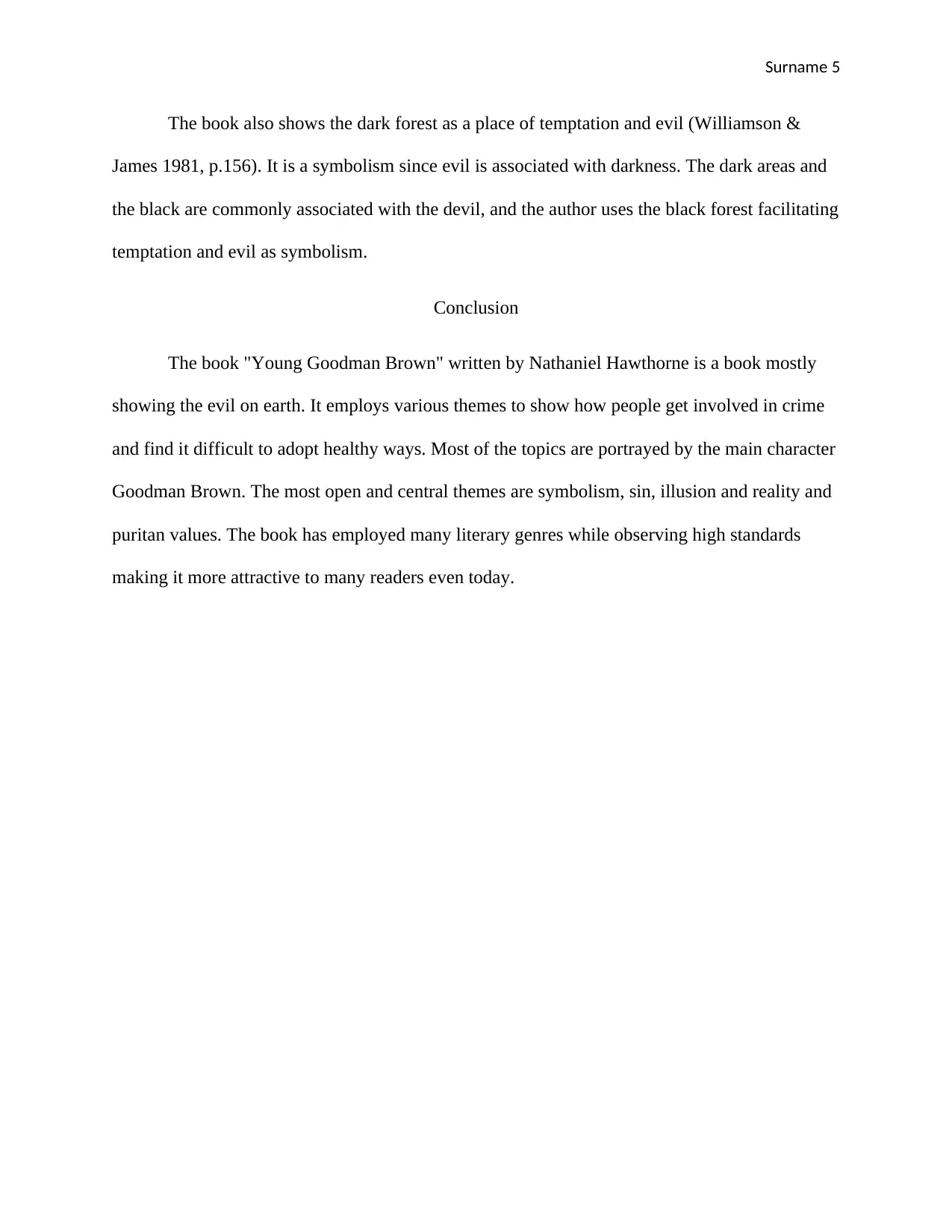
Surname 5
The book also shows the dark forest as a place of temptation and evil (Williamson &
James 1981, p.156). It is a symbolism since evil is associated with darkness. The dark areas and
the black are commonly associated with the devil, and the author uses the black forest facilitating
temptation and evil as symbolism.
Conclusion
The book "Young Goodman Brown" written by Nathaniel Hawthorne is a book mostly
showing the evil on earth. It employs various themes to show how people get involved in crime
and find it difficult to adopt healthy ways. Most of the topics are portrayed by the main character
Goodman Brown. The most open and central themes are symbolism, sin, illusion and reality and
puritan values. The book has employed many literary genres while observing high standards
making it more attractive to many readers even today.
The book also shows the dark forest as a place of temptation and evil (Williamson &
James 1981, p.156). It is a symbolism since evil is associated with darkness. The dark areas and
the black are commonly associated with the devil, and the author uses the black forest facilitating
temptation and evil as symbolism.
Conclusion
The book "Young Goodman Brown" written by Nathaniel Hawthorne is a book mostly
showing the evil on earth. It employs various themes to show how people get involved in crime
and find it difficult to adopt healthy ways. Most of the topics are portrayed by the main character
Goodman Brown. The most open and central themes are symbolism, sin, illusion and reality and
puritan values. The book has employed many literary genres while observing high standards
making it more attractive to many readers even today.
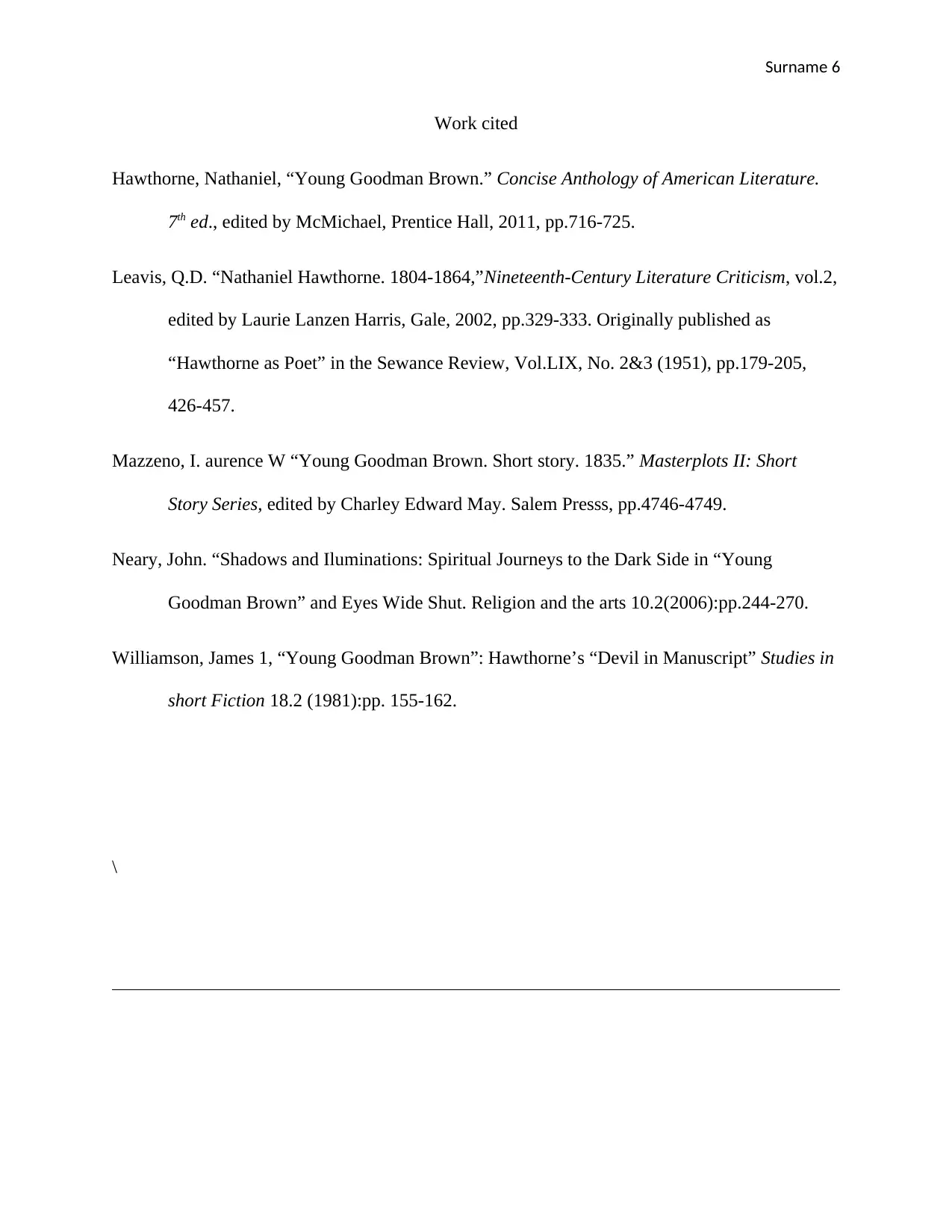
Surname 6
Work cited
Hawthorne, Nathaniel, “Young Goodman Brown.” Concise Anthology of American Literature.
7th ed., edited by McMichael, Prentice Hall, 2011, pp.716-725.
Leavis, Q.D. “Nathaniel Hawthorne. 1804-1864,”Nineteenth-Century Literature Criticism, vol.2,
edited by Laurie Lanzen Harris, Gale, 2002, pp.329-333. Originally published as
“Hawthorne as Poet” in the Sewance Review, Vol.LIX, No. 2&3 (1951), pp.179-205,
426-457.
Mazzeno, I. aurence W “Young Goodman Brown. Short story. 1835.” Masterplots II: Short
Story Series, edited by Charley Edward May. Salem Presss, pp.4746-4749.
Neary, John. “Shadows and Iluminations: Spiritual Journeys to the Dark Side in “Young
Goodman Brown” and Eyes Wide Shut. Religion and the arts 10.2(2006):pp.244-270.
Williamson, James 1, “Young Goodman Brown”: Hawthorne’s “Devil in Manuscript” Studies in
short Fiction 18.2 (1981):pp. 155-162.
\
Work cited
Hawthorne, Nathaniel, “Young Goodman Brown.” Concise Anthology of American Literature.
7th ed., edited by McMichael, Prentice Hall, 2011, pp.716-725.
Leavis, Q.D. “Nathaniel Hawthorne. 1804-1864,”Nineteenth-Century Literature Criticism, vol.2,
edited by Laurie Lanzen Harris, Gale, 2002, pp.329-333. Originally published as
“Hawthorne as Poet” in the Sewance Review, Vol.LIX, No. 2&3 (1951), pp.179-205,
426-457.
Mazzeno, I. aurence W “Young Goodman Brown. Short story. 1835.” Masterplots II: Short
Story Series, edited by Charley Edward May. Salem Presss, pp.4746-4749.
Neary, John. “Shadows and Iluminations: Spiritual Journeys to the Dark Side in “Young
Goodman Brown” and Eyes Wide Shut. Religion and the arts 10.2(2006):pp.244-270.
Williamson, James 1, “Young Goodman Brown”: Hawthorne’s “Devil in Manuscript” Studies in
short Fiction 18.2 (1981):pp. 155-162.
\
⊘ This is a preview!⊘
Do you want full access?
Subscribe today to unlock all pages.

Trusted by 1+ million students worldwide
1 out of 6
Your All-in-One AI-Powered Toolkit for Academic Success.
+13062052269
info@desklib.com
Available 24*7 on WhatsApp / Email
![[object Object]](/_next/static/media/star-bottom.7253800d.svg)
Unlock your academic potential
Copyright © 2020–2025 A2Z Services. All Rights Reserved. Developed and managed by ZUCOL.
